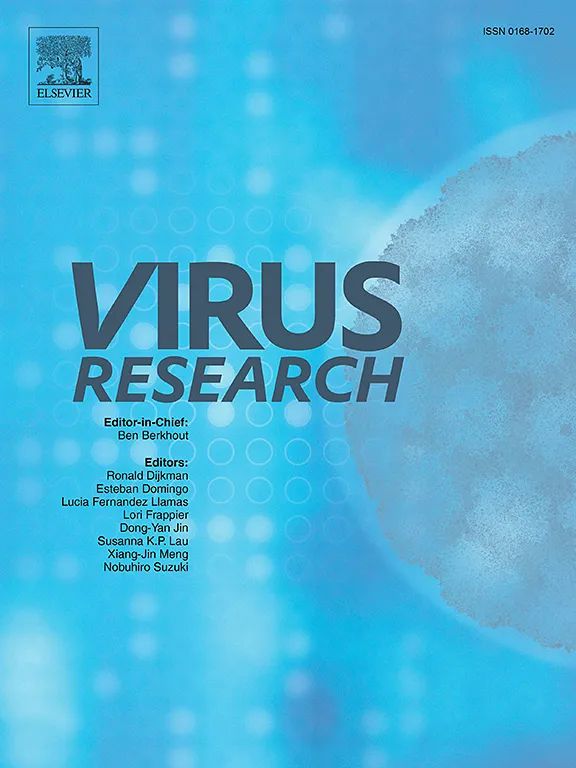综合转录组分析发现胆固醇转运途径是猪流行性腹泻冠状病毒的治疗靶点
IF 2.7
4区 医学
Q3 VIROLOGY
引用次数: 0
摘要
猪流行性腹泻病毒(PEDV)是一种传染性极强的病毒,对全球养猪业构成严重威胁。尽管做出了大量努力,但 PEDV 病毒进入的基本机制仍然难以捉摸。在本研究中,我们首先利用 PEDV 穗伪型水泡性口炎病毒鉴定了 PEDV 易感细胞系和非易感细胞系。随后,我们对这些细胞系进行了全面的转录组分析。通过将差异表达基因分析与加权基因共表达网络分析相结合,我们确定了与 PEDV 进入相关的关键通路。我们的分析发现,胆固醇、甾醇和脂质转运与 PEDV 的进入有很强的相关性,这表明胆固醇转运在 PEDV 的进入中可能发挥作用。为了进一步研究,我们用胆固醇转运抑制剂依折麦布(ezetimibe)处理了 Huh7、Vero 和 LLC-PK1 细胞,观察到这些细胞中的 PEDV 进入和随后的病毒复制都受到了显著抑制。有趣的是,用依泽替米贝预处理 Huh7 细胞会导致严重急性呼吸系统综合征冠状病毒 2(SARS-CoV-2)和中东呼吸系统综合征冠状病毒(MERS-CoV)伪病毒的进入增加。此外,我们还发现胆固醇可促进 PEDV 进入 Huh7 和 Vero 细胞,依折麦布可阻断这种促进作用。这些发现表明,以胆固醇转运为靶点可特异性地抑制 PEDV 进入易感细胞。我们的研究为了解 PEDV 进入细胞的机制和开发针对这种具有重要经济价值的病毒的新治疗策略提供了新的视角。本文章由计算机程序翻译,如有差异,请以英文原文为准。
Comprehensive transcriptomic analysis identifies cholesterol transport pathway as a therapeutic target of porcine epidemic diarrhea coronavirus
Porcine epidemic diarrhea virus (PEDV) is a highly contagious virus that poses a serious threat to the global pig industry. Despite extensive efforts, the mechanism underlying virus entry for PEDV remains elusive. In this study, we first identified PEDV-susceptible and non-susceptible cell lines by using PEDV spike pseudotyped vesicular stomatitis virus. Subsequently, we conducted a comprehensive transcriptomic analysis on these cell lines. Through integrating differential expression gene analysis with weighted gene co-expression network analysis, we identified the key pathways that are correlated with the PEDV entry. Our analysis revealed a strong correlation between cholesterol, sterols, and lipid transport with PEDV entry, suggesting a potential role for cholesterol transport in the PEDV entry. For further investigation, we treated Huh7, Vero and LLC-PK1 cells with a cholesterol transport inhibitor, ezetimibe, and observed a significant inhibition of PEDV entry and subsequent viral replication in these cells. Interestingly, pre-treating Huh7 cells with ezetimibe resulted in an increase in the entry of severe acute respiratory syndrome coronavirus 2 (SARS-CoV-2) and Middle East respiratory syndrome coronavirus (MERS-CoV) pseudoviruses. Moreover, we found that cholesterol could facilitate the entry of PEDV into Huh7 and Vero cells, and this promoting effect can be blocked by ezetimibe. These findings suggest that targeting cholesterol transport specifically inhibits PEDV entry into susceptible cells. Our study offers novel insights into the mechanism of PEDV entry and the development of new therapeutic strategies against this economically important virus.
求助全文
通过发布文献求助,成功后即可免费获取论文全文。
去求助
来源期刊

Virus research
医学-病毒学
CiteScore
9.50
自引率
2.00%
发文量
239
审稿时长
43 days
期刊介绍:
Virus Research provides a means of fast publication for original papers on fundamental research in virology. Contributions on new developments concerning virus structure, replication, pathogenesis and evolution are encouraged. These include reports describing virus morphology, the function and antigenic analysis of virus structural components, virus genome structure and expression, analysis on virus replication processes, virus evolution in connection with antiviral interventions, effects of viruses on their host cells, particularly on the immune system, and the pathogenesis of virus infections, including oncogene activation and transduction.
 求助内容:
求助内容: 应助结果提醒方式:
应助结果提醒方式:


